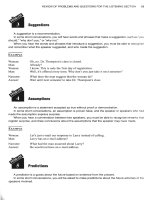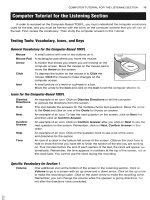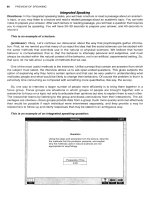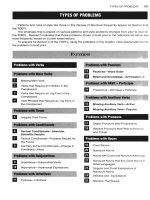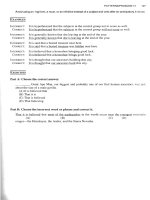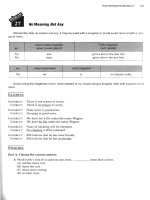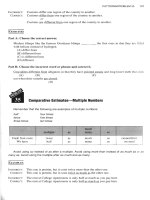Tài liệu How to prepare for the foefl part 22 pptx
Bạn đang xem bản rút gọn của tài liệu. Xem và tải ngay bản đầy đủ của tài liệu tại đây (963.05 KB, 10 trang )
OVERVIEW
OF THE
READING SECTION
209
Computer-Based
TOEFL
(CBT)
The directions for the Computer-Based
TOEFL
are reprinted with the permission of Educational
Testing Service (ETS) from the official
Information Bulletin
for the Computer-Based
TOEFL.
This section measures the ability to read and understand short passages similar in topic and style to
those that students are likely to encounter in North American universities and colleges. This section
contains reading passages and questions about the passages. There are several different types of ques-
tions in this section.
In the Reading section, you will first have the opportunity to read the passage.
You will use the scroll
bar
to view the rest
of
the passage.
atmosphere ends and the main body of the
Sun
begins.
The Sun's outermost layer begins about 10,000
miles above the visible surface and goes outward for
millions of miles. This is the only part of the Sun that
can be seen during an eclipse such as the one in
Feb~ary 1979. At any other time, the corona can
be seen only when special instruments are used on
cameras and telescopes to block the light from the
photosphere.
The corona is a brilliant, pearly white, filmy light,
about as bright as the full Moon. Its beautiful rays
are a sensational sight during an eclipse. The
corona's
rays
flash out in a brilliant fan that has wispy
spikelike rays near the Sun's north and south poles.
The corona is generally thickest at the Sun's equator.
The corona is made up of gases streaming
outward at tremendous speeds that reach a
temperature of more than
2
million degrees
Fahrenheit. The gas thins out as it reaches the
space around the planets. By the time the gas of
the corona reaches the Earth it has a relatively low
density.
v.
'.as*-
T
.
.
.m
7
oceed
7
+y~
?&
J'g
:X%$ yx
".
,'>
-1
be seen only when speclal
instruments
are used on
m
*-
7
The temperature of the Sun
IS
over 10,000
degrees
Fahrenheit
at the surface, but ~t nses to
perhaps more than 27,000,000° at the center The Sun
IS
so much hotter than the Earth that matter can exlst
only as a gas, except perhaps at the core In the core
of the Sun, the pressures are so great that, desp~te
the hlgh temperature, there may be a small
solid
core.
However, no one really knows, slnce the center of the
Sun can never be
directly
obsewed.
Solar astronomers do know that the Sun is
dtvlded
into
flve general layers or zones. Startlng at
the outslde and golng down lnto the Sun, the zones are
the corona, chromosphere, photosphere,
convection
zone, and finally the core The flrst three zones are
regarded as the Sun's atmosphere But slnce the
Sun has no solid surface, ~t
IS
hard to tell where the
atmosphere ends and the main body of the Sun
beglns.
The Sun's outermost layer beglns about 10,000
mlles above the vlslble surface and goes outward for
mllllons of mlles. Thls
IS
the only part of the Sun that
can
be
seen during an eclipse such as the one ~n
February 1979 At any other tlme, the corona can
-
-
'
210
REVIEW
OF
READING
When you have finished reading the passage, you will use the mouse to click on
Proceed.
Then the
questions about the passage will be presented. You are to choose the one best answer to each question.
Answer all questions about the information in a passage on the basis of what is stated or implied in that
passage.
Most of
the
questions will be multiple-choice questions. To answer these questions, you will click on a
choice below the question. Here is
an
example.
I I
However, no one really knows, since the center of the With what topic is paragraph
2
mainly
I
I
Sun
can
never be directly observed.
-+
Solar astronomers do know that the Sun is
divided into five general layers or zones. Starting at
the outside and going down into the sun, the zones are
the corona, chromosphere, photosphere, convection
zone, and finally the core. The first three zones are
regarded as the Sun's atmosphere. But since the
Sun has no solid surface, it is hard to tell where the
atmosphere ends and the main body of the Sun
begins.
The Sun's outermost layer begins about
10,000
miles above the visible surface and goes outward for
millions of miles. This is the only part
of
the Sun that
can be seen during an eclipse such as the one in
February
1979.
At any other time, the corona can
be seen only when special instruments are used on
cameras and telescopes to block the light from the
photosphere.
The corona is a brilliant, pearly white, filmy light,
about as bright as the full Moon. Its beautiful rays
are a sensational sight during an eclipse. The
corona's rays flash out in a brilliant fan that has wispy
spikelike rays near the Sun's north and south poles.
. .
concerned?
0
How the Sun evolved
0
'The structure of the Sun
0
Why scientists study the Sun
0
The distance of the Sun from the
planets
Paragraph
2
is marked with
an
arrow
[
-1.
The oval darkens to show which answer you have chosen. To choose a different answer, click on a dif-
ferent oval. The correct answer is indicated on the screen below.
ona is a brilliant, pearly white, filmy light,
as bright as the full Moon. Its beautiful rays
sensational sight during an eclipse. The
a's rays flash out in a brilliant fan that has wispy
ike rays near the Sun's north and south poles.
OVERVIEW
OF
THE
READING
SECTION
211
You will see the next question after you click on
Next.
To answer some questions, you will click on a
word or phrase. Here is an example.
I
I
Solar astronomers do know that the Sun is Look at the wordPMiJin the
1
I
divided into five general layers or zones. Starling at
the outside and going down into the sun, the zones are
the corona, chiomosphere, photosphere, convection
zone, and finally the core. The first three zones are
regarded as the Sun's atmosphere. But since the
Sun has no solid surface, it is hard to tell where the
atmosphere ends and the main
body
of the Sun
begins.
The
Sun's outermost layer begins about
10,000
miles above the visible surface and
goes outward for millions of miles.This is the
only part of the Sun that can be seen during an
eclipse such as themin February
1979.
At
any other time, the corona can be seen only when
special instruments are used on cameras and
telescopes to block the light from the photosphere.
The corona is a brilliant, pearly white, filmy light,
about as bright as the full Moon. Its beautiful rays
are a sensational sight during an eclipse. The
passage. Click on the word
or
phrase in the bold text that)llll(
refers to.
To
answer, you can click on any
part
of the word or phrase in the passage. Your choice will darken to
show which word you have chosen. The correct answer is indicated on the screen below.
t
.,,I
J
I I
solar astro~omers do know that the Sun
IS
dl
Look at the word-m the
I
I
zone, and finally the core. The first three zones are
regarded as the Sun's atmosphere. But since the
Sun has no solid surface, it is hard to tell where the
atmosphere ends and the main body of the Sun
begins.
The Sun's outermost layer begins about
10,000
miles above the visible surface and
goes outward for millions of miles.This is the
only part of the Sun that can be seen during an
-such as themin February
1979.
At
any other time, the corona can be seen only when
special instruments are used on cameras and
telescopes to block the light from the photosphere.
The corona is
a
brilliant, pearly white, filmy light,
about as bright as the full Moon. Its beautiful rays
are a sensational sight during an eclipse. The
212
REVIEW
OF
READING
see the next question after you click on
Next.
To answer some questions, you will click on a
in the passage. Here is an example.
You can click on any part of the sentence in the passage. The sentence will darken to show which
answer you have chosen. The correct answer
is
indicated below.
Click on the sentence in paragraph
4
or
5
in which the author compares the
light of the Sun's outermost layer to
that of another astronomical body.
spikelike rays near the Sun's north and south poles.
The corona is generally thickest at the Sun's equator.
+
The corona is made up of gases streaming
outward at tremendous speeds that reach a
temperature of more than
2
million degrees
Fahrenheit. The gas thins out as it reaches the
space around the planets. By the time the gas of
the corona reaches the Earth it has a relatively low
You will see the next question after you click on
Next.
OVERVIEW OF
THE
READING
SECTION
213
To answer some questions, you will click on a square to add a sentence to the passage.
Here
is
an
example.
At the center
of
the Earth's
xist only as a gas, except perhaps at the core. In the
solar system lies the Sun.
ore of the Sun, the pressures are so great that,
Where would it best fit in
Solar astronomers do know that the Sun is
no solid surface, it is hard to tell where the
ere ends and the main body of the Sun
When you click on a square, the sentence will appear in the passage at the place you have chosen. You
can
see
if
this is the best place to add the sentence, and you can click on another square to change your
answer.
The sentence will be added and shown in a dark box. The correct answer is indicated on the screen
below.
solar system lies the Sun.
Where would it best fit in
Solar astronomers do know that the Sun is
rded as the Sun's atmosphere. But since the
has no solid surface, it is hard to tell where
the
seen during an edipse such as the one in
ry
1979.
At any other time, the corona can
214
REVIEW
OF
READING
Next Generation
TOEFL
/
There are two types of tasks included in the Reading Section: independent reading tasks and in-
tegrated reading tasks.
Independent Reading
Directions:
There are between
36
and
39
questions in three independent reading passages on the Next
Generation
TOEFL.
Each passage is about
800
words in length. You may take notes as you read. The
topics are all academic. After each passage, you will answer
12
or
13
comprehension questions.
The comprehension questions are either multiple-choice with four possible answer choices or computer-
assisted with special directions on the screen. After every multiple-choice question, choose the best an-
swerchoice from four possible answers. After every computer-assisted question, follow the special di-
rections on the screen to complete the answer. It takes
25
minutes to complete each reading and to
answer
12
or
13
comprehension questions about it. There are three independent reading passages.
In the Reading Section you will first have the opportunity to read the passage. This is an example of
an independent reading passage.
The Developmental Stages of Infancy
Although each baby has an individual schedule
of motor development, general patterns of growth
have been observed. These patterns present
themselves as a result of the maturation of the motor
area in the brain and the rate at which the infant's
body structures and muscles develop. Researchers
in child development have proposed various theories,
but most have divided the stages into three basic
periods of development, including early infancy,
which extends from the first to the sixth month;
middle infancy, from the sixth to the ninth month; and
late infancy, from the ninth to the fiteenth month.
As the brain develops, the lower structures that
control reflexes mature before the higher structures
such as the cerebral cortex that influences higher-
order thinking. By the time that various muscles in
the neck, trunk, arms, and legs come under control,
You will use
the
scroll bar to continue reading the passage.
OVERVIEW
OF
THE
READING
SECTION
215
the older infant is prepared mentally as well as
physically to perform more difficult tasks. Since the
order of maturation within the brain and body
structure is generally the same for all babies, the
sequence of physical skills is usually the same as
well.
The newborn is concerned with his or her inner
world, responding primarily to hunger and pain.
Instinctive behaviors and reflexes like rooting and
sucking become more reliable through repetition,
governing its movements in response to stimuli. In
contrast, by early infancy, the baby is, for the most
part, aware of the surrounding world. During the
second month, many infants are awake more and
can raise their heads to look at things. They also
begin to smile at people as their visual focus and
perceptual abilities improve. Sometime between two
and three months, a universal pattern of staring at
the hand seems to occur. The frequency and length
of time spent on this activity increases, eventually
Continue to use
the
scroll
bar
to
read
the
passage.
leading to swiping at objects. Hand regard, as it is
sometimes referred to, is perhaps the first step in
intellectual curiosity and problem solving. By four
months, the baby is routinely holding its head up for
several minutes, it is able to roll over, and it begins
deliberate, more coordinated activities such as
searching for things, although it may not yet be able
to grasp them effectively with its hands. The four-
month-old is beginning to show preferences for
people and objects, and is especially responsive to
familiar faces. It is also beginning to be wary of
strangers and may scream when a visiting relative
tries to pick it up.
By five months, the baby is able to sit unaided,
grabbing objects and putting them into its mouth. By
doing this, the baby is demonstrating coordination of
several systems of behavior. In the first place, before
reaching, the object must be visually located, and
if
it is moving, it must be tracked, then the arm must
move accurately and the hand and fingers must
216
REVIEW
OF
READING
cooperate to accomplish a successful grasping
motion. Finally, the hand and fingers must be able to
hold the weight of the object while the eyes examine
it. In many instances, the wrist will move the object
back and forth, twisting it so that it can be viewed in
several different positions. Many babies use both
hands, and, at this point, some babies are already
trying to feed themselves with their hands. In
addition, they discover their feet, and begin to kick,
using the larger leg muscles.
In middle infancy, the baby concentrates on
practicing a great many speech sounds. Babbling
becomes a part of play. It also loves to imitate actions
and examine interesting objects more closely. At
about seven months, the baby begins to crawl, a skill
that it masters at the end of middle infancy. In late
Continue to use the scroll
bar
to read the passage.
-
has significant control over head and hand
movements, can examine objects within its reach,
and even has the ability to turn its body in a rolling
motion. The problem for an infant in the late stage is
that there are many objects that are in the field of
vision but not in the area of reach. The incredible
curiosity exhibited by babies is equaled by their effort
to master locomotion. Progress toward walking
moves through standing, pulling up, balancing, and
bouncing in place. Walking with the support of
furniture allows the baby to engage in "cruising," that
is, moving about unaided by caretakers, but
supported by objects. Finally, being led by others
allows the baby to release its hold on objects and
begin to walk independently. An important implication
of this sequence of accomplishments is the
increasing independence that allows older infants to
imitate adults and explore their environments.
It has been observed that the body parts
involved in each of the stages proceeds from the
+
. .
.
.
. .
. .
.
OVERVIEW OF
THE
READING
SECTION
217
head and goes down the body, a sequence that is
*
referred to as cephabcauda. Clearly,
the
brain and
1
the eyes must develop first for the baby to orient
,
itself. the neck muscles to kee~ its head u~riaht, the
i.
,".
arms and hands to grasp and bull up, the torso and
finally, the legs to complete the motions required for
walking. As soon as the baby walks well alone, it has
passed from infancy into the active toadler stage.
There may be
a
glossary to help you understand technical terms.
Glossary:
cephalocaudal:
from the head to the
tail
locomotion:
ability to move from place to place
When you have finished reading the passage, you
will
click on
Proceed.
Then the questions about
the passage
will
be presented. Follow the directions on the screen to answer the questions.
218
REVIEW
OF
READING
$xe
is an example of the passage with question references and questions:
The word- in the
passage is closest in
meaning to
0
often
0
naturally
0
for the most part
0
in a loud way
As the brain develops, the lower structures that
control reflexes mature before the higher structures
such as the cerebral cortex that influences higher-
order thinking. By the time that various muscles in
the neck, trunk, arms, and legs come under control,
the older infant is prepared mentally as well as
physically to perform more difficult tasks. Since the
order of maturation within the brain and body
structure is generally the same for all babies, the
sequence of physical skills is usually the same as
well.
The newborn iszoncerned with his or her inner
world, responding,@rimarily to hunger and pain.
Instinctive behaviors and reflexes like rooting and
sucking become more reliable through repetition,
governing its movements in response to stimuli. In
contrast, by early infancy, the baby is, for the most
part, aware of the surrounding world. During the
second month, many infants are awake more and
can raise their heads to look at things. They also
The correct answer
is
indicated below.
The word
"bfim
in the
passage is closest in
meaning to
0
often
0
naturally
0
for the most part
0
in a loud way
As the brain develops, the lower structures that
control reflexes mature before the higher structures
such as the cerebral cortex that influences higher-
order thinking. By the time that various muscles in
the neck, trunk, arms, and legs come under control,
the older infant is prepared mentally as well as
physically to perform more difficult tasks. Since the
order of maturation within the brain and body
structure is generally the same for all babies, the
sequence of physical skills is usually the same as
well.
The newborn is concerned with his or her inner
world, responding 'pzmaiily to hunger and pain.
Instinctive behaviors and reflexes like rooting and
sucking become more reliable through repetition,
governing its movements in response to stimuli. In
contrast, by early infancy, the baby is, for the most
part, aware of the surrounding world. During the
second month, many infants are awake more and
can raise their heads to look at things. They also
+
